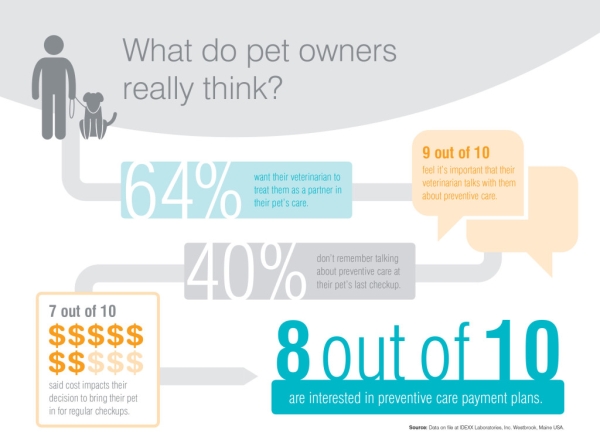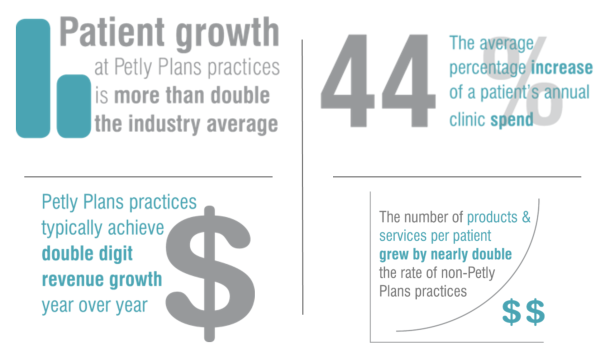Why preventive care?
The essential way to deliver the high-quality, affordable care your clients expect.

Happier clients, healthier pets.
Preventive care diagnostics help you identify disease earlier, expand treatment options, and improve outcomes. So you can always offer the highest quality of care to your patients.
Preventive care plans make routine visits, well, routine. So you can expect to see your clients' pets regularly, and you'll have revenue you can rely on.
Make consistent protocols a reality for your practice, so you can establish standards of care for every life stage and educate clients on the value of preventive care.
Healthier Pets.
Routine preventive care helps you identify disease earlier, expand treatment options, and provide the highest quality care.
-
Dr. Peter Brown shares the value of preventive care and preventive care plans in his veterinary practice in this quick video.
-
Preventive care plans make routine care more affordable for your clients by spreading the costs of services throughout the year.
-
Eight out of ten pet owners are interested in preventive care plans, regardless of their income.1
Better patient care with preventive care protocols.
Preventive care through routine visits and diagnostics is the best way to detect underlying diseases early. Early detection ensures more effective treatment, better prognoses, and healthier pets. And, common health problems like ear infections, dental disease, and obesity can be prevented through regular visits.
Preventive care diagnostics ensure the highest quality of care by helping you identify diseases earlier and expanding treatment options to improve outcomes.
Easy-to-understand preventive care protocols make it simple to involve pet owners in the care of the animals they love.
Regularly scheduled visits and screenings help owners understand the importance and the cadence of your recommended care, building trust between pet owners and your staff.
The AAHA guidelines clearly demonstrate the importance of regular laboratory profiling for the early detection of disease and the health and well-being of our pets. In addition, given the increasing occurrence and importance of infectious diseases in the pet population, most notably vector-borne diseases, many infectious disease experts are encouraging yearly screening of all age groups for infectious diseases common in the patient's geographic area.
Peter Kintzer DVM, DACVIM
Medical Affairs, IDEXX Laboratories
Generate consistent revenue while helping your clients spread the cost of quality care throughout the year.
1. Plan memberships keep your clients coming back
Fully engaged Petly Plans customers have experienced practice growth well above the industry average3
- 2x the patient growth over a 3-year period compared to the industry average
- Double-digit revenue growth year over year
- 44% increase in average patient’s annual clinic spend
- 2x higher growth rate on the products and services provided per patient
2. Standardize preventive care protocols in your practice
With a practice-wide approach to client education, clients will hear about the value of preventive care from every member of your team. And they’ll experience consistent, high-quality care with every visit.
3. Provide comprehensive, routine care for every patient
Monthly payment plans make it easy for pet owners to say “yes” to high-quality preventive care without worrying about cost. And your clients can always buy more services as a result of findings from more regular visits.
Consistent protocols throughout your practice.
Delivering a consistent message throughout your practice is critical to building trust and strong relationships with your clients as well as driving overall compliance.
1. Establish consistent preventive care protocols
Whether a single doctor practice or multiple doctor practice, it is critical to have a standard set of protocols throughout your practice.
Check out 'How Old is Your Pet in People Years?'
2. Define standards of care for each stage of life
Pets age much faster than we do. They enter their senior years beginning around age 7 and often begin to develop diseases common to that of a senior human: diabetes, heart disease, thyroid disease, and cancer. That’s why it’s important to begin testing early to establish baseline values to improve diagnostic accuracy with individual reference intervals throughout the life of the pet.
3. Educate your clients on the value of preventive care diagnostics
Your patients can’t tell you or their owners how they feel. Most pet owners assume their pet is healthy until they look or act as though something is wrong. In fact, one in ten pets that appear healthy to their owners during regular checkups actually have underlying diseases.2 That’s why it is important to educate pet owners on their role in helping combat illness. Awareness of the warning signs and regular checkups, including physical exams and blood work, are the best ways to ensure that your pet lives a long, healthy, and happy life.

Case Study: Care Animal Hospital
See how Care Animal Hospital increased client spend by 132%.


